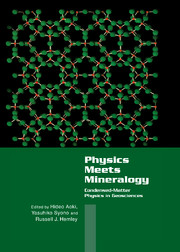Book contents
- Frontmatter
- Contents
- Preface
- List of Contributors
- Part I Introduction
- Part II Advances in Theoretical and Experimental Techniques
- Part III New Findings in Oxides and Silicates
- Part IV Transformations in Silica
- Part V Novel Structures and Materials
- Part VI Melts and Crystal–Melt Interactions
- Chapter 6.1 Comparison of Pair-Potential Models for the Simulation of Liquid SiO2: Thermodynamic, Angular-Distribution, and Diffusional Properties
- Chapter 6.2 Transport Properties of Silicate Melts at High Pressure
- Chapter 6.3 Structural Characterization of Oxide Melts with Advanced X-Ray-Diffraction Methods
- Chapter 6.4 Computer-Simulation Approach for the Prediction of Trace-Element Partitioning Between Crystal and Melt
- Subject Index
- Materials Formula Index
- Index of Contributors
Chapter 6.3 - Structural Characterization of Oxide Melts with Advanced X-Ray-Diffraction Methods
Published online by Cambridge University Press: 05 November 2011
- Frontmatter
- Contents
- Preface
- List of Contributors
- Part I Introduction
- Part II Advances in Theoretical and Experimental Techniques
- Part III New Findings in Oxides and Silicates
- Part IV Transformations in Silica
- Part V Novel Structures and Materials
- Part VI Melts and Crystal–Melt Interactions
- Chapter 6.1 Comparison of Pair-Potential Models for the Simulation of Liquid SiO2: Thermodynamic, Angular-Distribution, and Diffusional Properties
- Chapter 6.2 Transport Properties of Silicate Melts at High Pressure
- Chapter 6.3 Structural Characterization of Oxide Melts with Advanced X-Ray-Diffraction Methods
- Chapter 6.4 Computer-Simulation Approach for the Prediction of Trace-Element Partitioning Between Crystal and Melt
- Subject Index
- Materials Formula Index
- Index of Contributors
Summary
X-ray-diffraction technique is one of the powerful tools for determining the atomic scale structures of oxide melts at high temperature. This chapter describes the conventional angle dispersive x-ray-diffraction (ADXD) results with some selected examples of pure oxide, binary silicate and borate melts. The usefulness of the energy dispersive x-ray-diffraction (EDXD) method coupled with a solid-state detecting system has been demonstrated by obtaining the results for the complex oxide melts of NaAlSi3O8 and LiNbO3. The relatively new devised technique of anomalous x-ray scattering (AXS), which enables us to provide the environmental structural image around a specific element, is also discussed by using the local structure around Ge in germanate glasses.
Introduction
There is an increasing demand for understanding various properties of oxide melts, not only from metallurgical and petrological points of view but also from a new perspective of the crystal-growth technique through molten states. This has encouraged number of measurements of density, viscosity, surface tension, and electrical conductivity of oxide melts. To clarify their characteristic properties, a knowledge of the atomic-scale structures of oxide melts is essential, and particularly x-ray diffraction has been one of the most popular methods for the in situ structural analysis of materials since the first liquid result made by Debye in 1915 [1]. Recently, several modern x-ray-diffraction techniques have been developed for determining the fine local structure of oxides in both the molten and the glassy states. This chapter provides an extended discussion of the structure of oxide melts at high temperatures obtained by several advanced diffraction techniques.
- Type
- Chapter
- Information
- Physics Meets MineralogyCondensed Matter Physics in the Geosciences, pp. 354 - 380Publisher: Cambridge University PressPrint publication year: 2000



